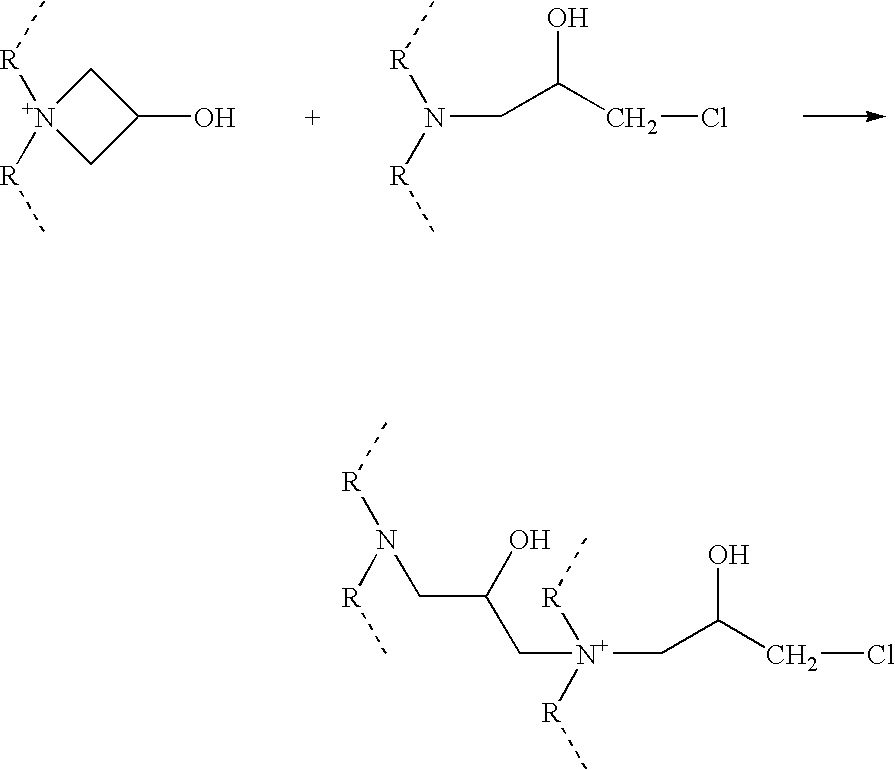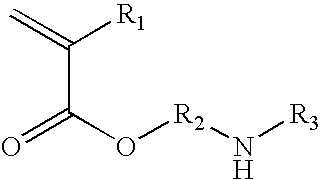Azetidinium modified polymers and fabric treatment composition
a technology of modified polymers and fabric, applied in the direction of detergent compositions, detergent compounding agents, chemistry apparatus and processes, etc., can solve the problems of unwanted changes in appearance and difficult removal of certain stains
- Summary
- Abstract
- Description
- Claims
- Application Information
AI Technical Summary
Benefits of technology
Problems solved by technology
Method used
Image
Examples
example 1
Preparing Aminoethylmethacrylate Hydrochloride
[0104]A 500 ml 2 neck round bottomed flask was charged with 2-aminoethanol hydrochloride (46.2 g, 0.47 m) and methacryloyl chloride (49.11 g, 0.47 mols). To this hydroquinone (1 mol %, 0.5 g) was added to prevent polymerisation. The fused mass was then heated to 85-100° C. with cautious stirring until no more hydrogen chloride evolved (12 h). The amino ester hydrochloride formed was recrystallised from dry dichloroethane and vacuum dried to give a white crystalline solid (63 g, 84%).
[0105](δH 500 MHz; CDCL3) 1.95 (3H, s, CH3) 3.66 (2H, m, —CH2—) 4.5 (2H, t, J 5 Hz, —CH2—) 5.62 (H, s, vinyl CH) 6.27 (H, s, vinyl CH) 8.38 (3H, bs, NH3+).
example 2
Polymerising Aminoethylmethacrylate Hydrochloride with Oligoethyl-Methacrylate Monomethyl Ether (M.wt. 430) 1:1 Molar Ratio
[0106]Aminoethylmethacrylate hydrochloride (5 g, 0.03 mols, 1 equivalent), oligoethylmethacrylate monomethyl ether (M. wt. 430) (13 g, 0.03 mols 1 equivalent) and AIBN (0.18 g, 1% w / w) were dissolved in water (180 ml). The solution was degassed via the freeze-pump-thaw method and purged with nitrogen. The flask was sealed and the solution stirred with heating at 80° C. for 12 hours. The polymer solution was then freeze dried and the polymer re-dissolved in THF. This organic solution was then added dropwise to vigorously stirring chilled (−20° C.) hexane to give the polymer as a white precipitate. The precipitate was then filtered off and washed with a further amount of chilled non-solvent to give a clear sticky polymer (16.9 g, 94%).
example 3
Functionalisation with Epichlorohydrin
[0107]The previously prepared polymer of example 2 (2 g, 2.88 mmol equivalents based on amine level) was dissolved in water (20 ml) and basified with NaOH solution until pH 10. Epichlorohydrin (0.27 g, 2.88 mmols, 1 equivalent) was added to the solution and stirring was continued at room temperature for either 2 or 4 hours before the solution was acidified with HCl solution to pH 4.
PUM
| Property | Measurement | Unit |
|---|---|---|
| temperatures | aaaaa | aaaaa |
| temperatures | aaaaa | aaaaa |
| transition temperature | aaaaa | aaaaa |
Abstract
Description
Claims
Application Information
 Login to View More
Login to View More - R&D
- Intellectual Property
- Life Sciences
- Materials
- Tech Scout
- Unparalleled Data Quality
- Higher Quality Content
- 60% Fewer Hallucinations
Browse by: Latest US Patents, China's latest patents, Technical Efficacy Thesaurus, Application Domain, Technology Topic, Popular Technical Reports.
© 2025 PatSnap. All rights reserved.Legal|Privacy policy|Modern Slavery Act Transparency Statement|Sitemap|About US| Contact US: help@patsnap.com



